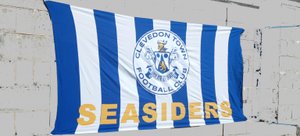
2. History 2
Post War
After the War they again returned to the Western League and, despite a moderate league record, built up a reputation for themselves in the F A Amateur Cup, reaching the Rounds Proper no less than 8 times in 13 years. In those days that was no mean achievement and their success brought them to the attention of the national press. There were many notable victories, including home success over Brigg Sports, Ilford and Dartmouth United. They also faced the mighty Pegasus, Harwich & Parkeston (who went on to reach the 1953 Final), Wimbledon (then an Isthmian League side), Billingham Synthonia and Carshalton Athletic.
The F A Cup also brought success with several tussles against Southern League opposition. One of the finest performances was at Merthyr Tydfil when 10,000 people gave them a long ovation after they were defeated 2-1 after losing a player with a broken leg after just 20 minutes. The record home gate was recorded against Bath City in September 1951 when 2,300 witnessed a 3-1 win for the Southern Leaguers.
Cup success, however, was not matched in the league and they spent several years in Division 2 before resigning, for financial reasons, at the end of the 1957/1958 season. They joined the Bristol & District League where they remained for 15 years, before rejoining the Western League in 1973/1974 after amalgamating with another local club, Ashtonians United, who were already members of the Western League ranks. The club's name was later changed to Clevedon Town to reflect their new status. With the breaking up of the old amateur status, Clevedon joined the professional ranks in 1974 with Ray Mabbutt (father of Spurs captain, Gary Mabbutt), becoming the first paid player.
The building of a new clubhouse and the installation of floodlights in the early 1980's nearly bankrupted the club. Debts were running at well over £100,000 and desperate measures had to be taken to save the club. The Board of Directors was forced to resign and the introduction of several new faces saved the club from total disaster, with the overdraft being reduced by careful budgeting and management. After many years as a mid-table side things began to change a few years ago when the club decided to sell their Teignmouth Road ground and move to a new site at Davis Lane on the edge of the town. The club had the foresight to buy the Teignmouth Road site for £450 in 1949 and this wise move enabled the club to sell off the ground, pay off their remaining debts and build a purpose built stadium from the proceeds.

